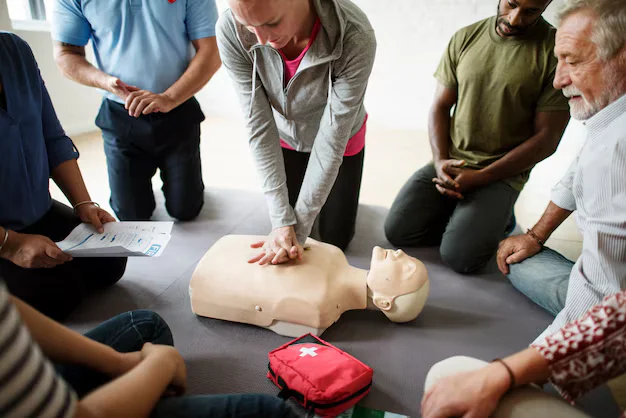Introduction
Choking is a critical medical emergency that can happen anywhere, including the workplace. Employees often eat at their desks or in break rooms, increasing choking risks. In fast-paced work environments, eating quickly or while talking heightens these risks. If not treated immediately, choking can lead to loss of consciousness or death within minutes. It is vital to train employees in essential first aid to ensure workplace safety. Proper training empowers individuals to respond effectively, potentially saving lives before medical help arrives. Choking happens when an object, like food, blocks the airway. If the blockage is partial, the person might cough or make noise, indicating some air passage. However, complete blockage prevents breathing, coughing, or speaking, requiring immediate action.
Common choking signs include throat clutching, inability to speak or breathe, and skin color changes due to oxygen lack. Sometimes, victims may seem fine before suddenly collapsing due to oxygen depletion. Early recognition of these symptoms allows for quick first aid intervention.
First Aid Response for Choking
If someone is choking but can cough, encourage them to continue coughing to dislodge the object. If they cannot breathe, immediate first aid is necessary. The first step is back blows. Stand behind the choking person and deliver five strong blows between their shoulder blades. If this doesn’t work, move to abdominal thrusts, or the Heimlich maneuver. Wrap your arms around their waist, place one fist above their navel, and press inward and upward. Repeat until the object is expelled. For pregnant individuals or those in wheelchairs, chest thrusts are safer. Place your hands at the center of their chest and push inward and slightly upward. These modifications ensure first aid can be applied to various needs.
Training programs like the HLTAID011 Provide First Aid Course Online teach employees to recognize and respond to choking emergencies. By participating, employees gain hands-on experience in life-saving techniques. The ability to apply proper first aid in choking emergencies can be life-saving.
The Importance of Workplace First Aid Training
Choking is just one of many emergencies that can occur in the workplace, making first aid training crucial. Employees trained in first aid are better equipped to handle various emergencies, including choking and cardiac arrests. A Corporate First Aid Course provides a comprehensive understanding of first aid procedures. This ensures employees can act quickly and effectively in emergencies. Having trained personnel in the workplace makes it safer for everyone. In high-risk industries like hospitality and manufacturing, where choking hazards are common, first aid training is especially important.
Preventing Choking in the Workplace
While first aid training is vital for emergencies, prevention should be the primary focus. Workplaces can reduce choking risks by:
Encouraging safe eating habits: Remind employees to eat slowly, chew properly, and avoid eating while talking or laughing.
Creating designated eating areas: Ensure meals are eaten in a relaxed setting, not at workstations, to lower choking risks.
Educating employees about choking risks: Awareness programs can help employees understand how to prevent choking and what to do in emergencies.
Ensuring easy access to first aid kits: First aid kits should be well-stocked with tools like resuscitation masks and easily accessible in emergencies.
Employers can greatly diminish the risk of choking incidents by promoting a culture of safety in the workplace. This approach also ensures that employees are ready to act when emergencies arise.
The Role of Refresher Training in Workplace Safety
Regular practice of first aid skills is crucial to maintain employee confidence. Many organizations schedule annual refresher courses to update employees on the latest first aid methods. This continuous training enables employees to respond swiftly and correctly in emergency situations. Moreover, employers should encourage open discussions about workplace safety and emergency readiness. When employees are informed about potential hazards and confident in their response abilities, the workplace environment becomes safer and more supportive for all. Consistently reinforcing these skills helps create a culture of preparedness, ensuring safety remains a top priority.
Conclusion
Choking incidents in the workplace can be extremely dangerous, but with the right training and readiness, employees can intervene effectively and prevent severe consequences. It is vital for employees to recognize choking signs, apply back blows and abdominal thrusts, and remain calm under pressure. Proper training ensures that employees can respond swiftly, reducing the chances of long-term complications or fatalities. Additionally, designated first aid responders in the workplace can act immediately before medical professionals arrive, increasing survival rates in emergencies. By integrating first aid training into workplace safety initiatives, employers can lower the risks associated with choking and other medical emergencies. A well-prepared workforce not only improves workplace safety but also instills a sense of security and responsibility among employees. Regular refresher courses help reinforce essential life-saving techniques, ensuring employees retain their confidence and skills over time. Ensuring readiness for emergencies goes beyond compliance; it is about creating a safer, healthier, and more supportive work environment for everyone.







